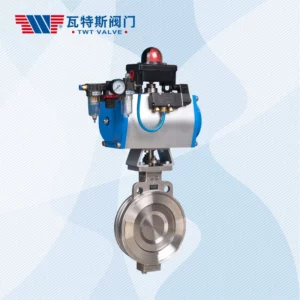Double offset butterfly valves and traditional butterfly valves differ significantly in terms of their design and performance characteristics, which, in turn, affects their applications.
Here’s a comparison of the two:
- Design and Offset:
- Traditional Butterfly Valves: Traditional butterfly valves have a single offset design. This means that the center of the valve disc is positioned slightly off-center from the centerline of the pipe, allowing for a bubble-tight shut-off but limited performance in higher-pressure or high-temperature applications.
- Double Offset Butterfly Valves: Double offset butterfly valves have two offsets. The first offset, known as the “double offset,” is the offset from the centerline of the pipe. The second offset is the rotation axis of the disc, which is positioned behind the plane of the sealing surface. This design provides a more effective seal and superior performance.
- Sealing Mechanism:
- Traditional Butterfly Valves: Traditional butterfly valves typically use a soft or resilient seat for sealing. While they provide good sealing in low to moderate-pressure applications, they are not well-suited for high-performance applications.
- Double Offset Butterfly Valves: Double offset butterfly valves often use a metal-to-metal or high-performance seat. This design enables them to achieve bubble-tight shutoff, even in high-pressure and high-temperature environments.
- Performance in High-Pressure and High-Temperature Applications:
- Traditional Butterfly Valves: Traditional butterfly valves may struggle to maintain a seal in high-pressure or high-temperature applications, which limits their use in these scenarios.
- Double Offset Butterfly Valves: Double offset butterfly valves are designed to perform exceptionally well in high-pressure and high-temperature applications. They are often used in industries like oil and gas, petrochemical, and power generation.
- Bi-Directional Sealing:
- Traditional Butterfly Valves: Traditional butterfly valves typically provide unidirectional sealing, meaning they can seal effectively in one direction only.
- Double Offset Butterfly Valves: Double offset butterfly valves offer bi-directional sealing capabilities, making them suitable for applications where flow can change direction.
- Control and Throttling:
- Traditional Butterfly Valves: Traditional butterfly valves are often used for on-off or modulating service in applications where precise control is not required.
- Double Offset Butterfly Valves: Double offset butterfly valves are suitable for both on-off and throttling services due to their improved sealing and control capabilities.
In summary, double offset butterfly valves outperform traditional butterfly valves in high-pressure, high-temperature, and critical applications that demand superior sealing and control. double offset high performance butterfly valve Traditional butterfly valves are more commonly used in low-pressure, low-temperature applications where cost is a primary consideration. The choice between the two types of valves depends on the specific requirements of the application.
How are these valves suitable for controlling and throttling flow in various applications?
Double offset butterfly valves are suitable for controlling and throttling flow in various applications due to their design features and capabilities. Here’s how they are well-suited for such tasks:
- Precise Flow Control: Double offset butterfly valves have improved sealing mechanisms, allowing for precise control of flow rates. They can be used to regulate the flow of liquids, gases, or slurries in a system, which is essential in processes that require accurate flow adjustments.
- Wide Range of Flow Rates: These valves can handle a wide range of flow rates, from full open to nearly closed positions, making them versatile in applications where flow modulation is required.
- Bi-Directional Flow Control: Double offset butterfly valves can effectively control flow in both directions, allowing for bidirectional operation. This is important in systems where the flow can change direction, and the valve must maintain effective control regardless of the flow direction.
- High-Pressure Applications: Due to their design and materials, double offset butterfly valves are capable of withstanding high-pressure conditions. They are commonly used in applications such as power generation, oil and gas, and petrochemical industries where precise control of high-pressure fluids or gases is crucial.
- High-Temperature Applications: Double offset butterfly valves are designed to handle elevated temperatures, making them suitable for applications in industries where hot or thermal fluids are involved.
- Bubble-Tight Shut-off: The improved sealing mechanisms and double offset design ensure bubble-tight shut-off. This is essential in applications where preventing leakage or system contamination is critical.
- Reduced Pressure Drop: Double offset butterfly valves have a streamlined design, which helps reduce pressure drop across the valve. This can lead to energy savings and increased efficiency in fluid systems.
- Low Maintenance: These valves are known for their low maintenance requirements, which is advantageous in applications where reliability is crucial.
- Versatility: Double offset butterfly valves can be used in a wide range of industries, including water and wastewater, chemical processing, HVAC, and more. Their versatility in controlling flow makes them a popular choice.
- Cost-Effective Solutions: These valves often offer a cost-effective alternative to other types of control valves, such as globe valves or ball valves, while still providing precise flow control.
In summary, double offset butterfly valves are well-suited for controlling and throttling flow in various applications due to their precision, bidirectional sealing, pressure and temperature capabilities, low maintenance requirements, and cost-effectiveness. Their suitability depends on the specific requirements of the system and the nature of the fluids or gases being controlled.

